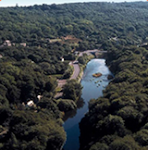Wednesday 17th September 2025, Treflach Farm
Our destination this week was Treflach Farm in the Oswestry uplands. I can best sum up its ‘mission’ by quoting directly from its website “In August 2006 Ian Steele returned to the family farm from working in London and abroad in the Petrochemical Industry. So began a journey to revitalise a small scale, hillside farm in the family since 1904. The aim was to prove that small scale agriculture can indeed be environmentally aware, promote biodiversity and remain viable in the modern world.”
After months of blameless weather, our visit continued the recent trend of wet Wednesdays. So wet in fact that several of the group, having perused the weather forecast, decided that their warm, dry houses sounded like a much better idea and stayed at home! However, a brave (foolhardy?) few decided to bash on.
On arrival, the rain was still falling, though not as heavily as it had been.
 |
| Photograph: David Williams |
Everything was, of course, soaked. Waterproofs were donned and vacuum samplers readied for action.
Grassland near the farm buildings was the first area to be examined. This produced several ladybird species, including a suitably bedraggled 7-spot Ladybird...
Other finds included:
A Straw Dot, Rivula sericealis (on the left) and a stiltbug, Berytinus minor, (on the right);
Adonis' Ladybird, Hippodramia variegata;
Drinker larva, Euthrix potatoria;
A plantbug, a species Lygus;
 |
| Photograph: Nigel Cane-Honeysett |
Dock Bug, Coreus marginatus;
 |
| Photograph: Nigel Cane-Honeysett |
And a less fortunate 7-spot ladybird that has been parasitised by the wasp Dinocampus coccinellidae. The ladybird is "glued" in place by the pupating wasp causing the ladybird to starve to death.
A plant bug, Pantilius tunicatus;
A missing segment spider, Zygiella x-notata;
 |
| Photograph: Nigel Cane-Honeysett |
Lunch time arrived. It was still raining. We retreated to a convenient building for shelter, during which time the rain abated and rather miraculously the sun appeared, albeit rather fitfully.
Lunch over, we made our way down to the bottom of the site where a marshy field and pond were our targets. Here, we found:
Red Marsh Ladybird, Coccidula rufa;
A fungus, Taphrina alni that has grown from an Alder catkin;
 |
| Photograph: Nigel Cane-Honeysett |
Extricating ourselves from the marsh, we headed for a grassy hillock on which trees had recently been planted. By now the brisk wind was doing a surprisingly good job of drying the sodden vegetation.
More 22-spot Ladybirds were found, this time also including some 24-spots, Subcoccinella vigintiquattuorpunctata.
Blue Shieldbug, Zicrona caerulea;
 |
| Photograph: Nigel Cane-Honeysett |
It was also nice to see Encephalus complicans for the first time in 2025, a tiny (less than 3mm) and remarkably flexible rove beetle, whose party trick is to curl its abdomen over its back so that it forms an almost perfect ball.
This area also produced the Weevil of the Week, Hadroplontus litura.
 |
| Photograph: David Williams |
Time remained for us to explore an area of woodland at the edge of the site. This produced a fine display of earthstar fungi...
 |
| Photograph: David Williams |
A leaf mine was spotted in a Primrose. This seems to be caused by a species of fly, Chromatomyia primulae.
 |
| Photograph: David Williams |
After this, we made a slow return to our vehicles and thence homewards, having had a much fuller day than we had feared when we had set off in the morning.
My thanks to the owners for inviting us to visit and do what we enjoy doing and their hospitality. My immense gratitude to the photographers for their excellent images.





















































Excellent finds in difficult circumstances!
ReplyDeleteGlad you found it and had such a good day!
ReplyDelete